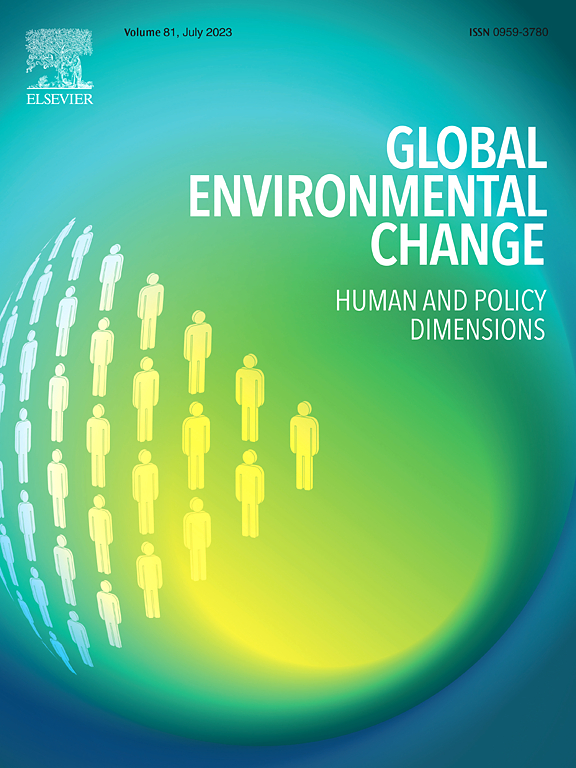农村循环迁移在影响印度、尼泊尔和孟加拉国小农天气风险管理中的作用
IF 9.1
1区 环境科学与生态学
Q1 ENVIRONMENTAL SCIENCES
引用次数: 0
摘要
循环迁移是指移民返回原籍地的迁移,它已成为农村生计中一个日益重要的组成部分,并可能对小农家庭在气候变化面前的风险管理战略产生重大影响。为了揭示气候变化、移民决策和小农家庭农业成果之间的关联,我们采用了一种嵌入式混合方法,使用了来自尼泊尔、印度和孟加拉国 2000 多个农村家庭的结构化家庭调查的定量数据,以及来自访谈和焦点小组讨论的定性数据。我们利用这些数据来确定社会经济、气候和天气因素对长期(≥12 个月)和短期(<12 个月)迁移决策的影响,以及迁移对农业风险管理战略的影响。我们的研究表明,移徙的驱动因素和影响因移徙特征而异,包括家庭成员移徙的时间长短以及目的地是国内还是国际。我们发现,资源有限的家庭,如灌溉条件有限的家庭,会利用短期移民来应对天气变化,而长期移民一般由较富裕的家庭进行,其动机是改善长期经济成果。考虑到移徙对风险管理的影响,我们发现家庭成员的短期移徙会增加对农业的投资,如增加投入和采用新品种。相比之下,长期移民和国际移民则会导致农业投资减少,如减少种植面积和投入。我们的研究结果凸显了移民在气候变化挑战下影响农业管理实践的重要性。本文章由计算机程序翻译,如有差异,请以英文原文为准。
The role of rural circular migration in shaping weather risk management for smallholder farmers in India, Nepal, and Bangladesh
Circular migration, defined as migration where migrants return to their original home area, has become an increasingly important component of rural livelihoods and can significantly impact the risk management strategies of smallholder agricultural households in the face of climate change. To unpack the associations between climate change, migration decisions, and agricultural outcomes for smallholder agricultural households, we use an embedded mixed methods approach that uses quantitative data from a structured household survey from over 2,000 rural households in Nepal, India, and Bangladesh, along with qualitative data from interviews and focus group discussions. We use these data to identify the influence of socio-economic, climate, and weather factors on long (≥12 months) and short-term (<12 months) migration decisions and the impacts of migration on risk management strategies in agriculture. Our research shows that the drivers and effects of migration differ based on migration characteristics, including the length of time a family member migrates and whether the destination is domestic or international. We find that households with limited resources, such as constrained irrigation access, use short-term migration to cope with weather variability, whereas long-term migration is generally undertaken by wealthier households motivated to improve long-term economic outcomes. Considering the impacts of migration on risk management, we find that short-term migration of household members results in increased investment in agriculture, such as increasing inputs and adopting new varieties. In contrast, long-term and international migration is associated with disinvestments in agriculture, such as reduced cropped area and inputs. Our results highlight the importance of migration in shaping agricultural management practices amidst the challenges of climate change.
求助全文
通过发布文献求助,成功后即可免费获取论文全文。
去求助
来源期刊

Global Environmental Change
环境科学-环境科学
CiteScore
18.20
自引率
2.20%
发文量
146
审稿时长
12 months
期刊介绍:
Global Environmental Change is a prestigious international journal that publishes articles of high quality, both theoretically and empirically rigorous. The journal aims to contribute to the understanding of global environmental change from the perspectives of human and policy dimensions. Specifically, it considers global environmental change as the result of processes occurring at the local level, but with wide-ranging impacts on various spatial, temporal, and socio-political scales.
In terms of content, the journal seeks articles with a strong social science component. This includes research that examines the societal drivers and consequences of environmental change, as well as social and policy processes that aim to address these challenges. While the journal covers a broad range of topics, including biodiversity and ecosystem services, climate, coasts, food systems, land use and land cover, oceans, urban areas, and water resources, it also welcomes contributions that investigate the drivers, consequences, and management of other areas affected by environmental change.
Overall, Global Environmental Change encourages research that deepens our understanding of the complex interactions between human activities and the environment, with the goal of informing policy and decision-making.
 求助内容:
求助内容: 应助结果提醒方式:
应助结果提醒方式:


